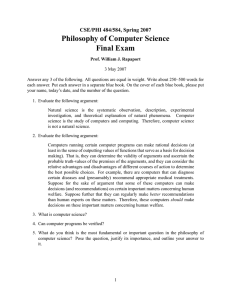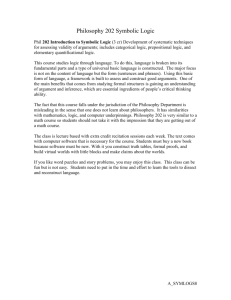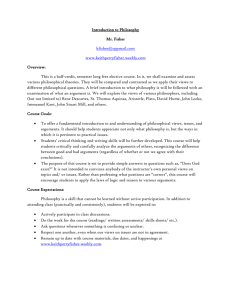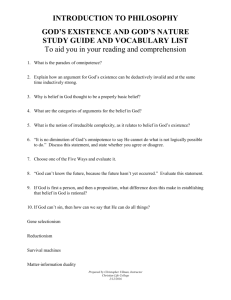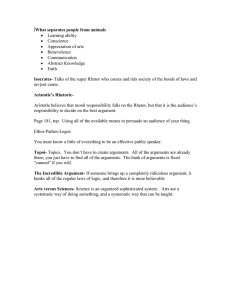Digging by Debating (DbyD):
advertisement
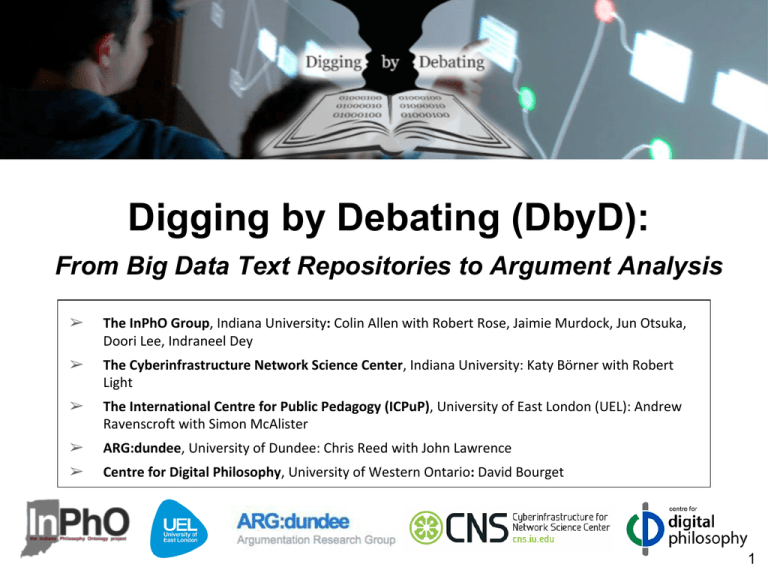
Digging by Debating (DbyD): From Big Data Text Repositories to Argument Analysis ➢ The InPhO Group, Indiana University: Colin Allen with Robert Rose, Jaimie Murdock, Jun Otsuka, Doori Lee, Indraneel Dey ➢ The Cyberinfrastructure Network Science Center, Indiana University: Katy Börner with Robert Light ➢ The International Centre for Public Pedagogy (ICPuP), University of East London (UEL): Andrew Ravenscroft with Simon McAlister ➢ ARG:dundee, University of Dundee: Chris Reed with John Lawrence ➢ Centre for Digital Philosophy, University of Western Ontario: David Bourget 1 From Big Data to Argument Analysis Linking massive datasets to specific arguments, where ‘text is data’ Project Goals ● ● Uncover and represent the key argumentative structures of digitized documents from a large philosophy/science corpus; Allow users to find and interpret detailed arguments in the broad semantic landscape of books and articles, and to support innovative interdisciplinary research and better-informed critical debates Data Sources Stanford Encyclopedia of Philosophy, HathiTrust Collection, PhilPapers 4 Levels of Analysis: Macro (Sci/Phil Maps) to Micro (detailed arguments) 1. 2. 3. 4. Visualizing points of contact between philosophy and the sciences Topic modeling to identify the volumes/pages ‘rich’ in a chosen topic; Identify and map key arguments; apply a novel analysis framework for propositions and arguments; Sentence modeling to get back to HathiTrust materials 2 Mapping Philosophy in the Sciences (analysis level 1) ❏ ❏ ❏ ❏ UCSD Map of Science: generated using more than 12M papers and their references from Elsevier’s Scopus and Thomson Reuters’ Web of Science (25,000 journals), see http://sci. cns.iu.edu/ucsdmap Shows 554 subdiscipline nodes aggregated into 13 color-coded disciplines. Overlaid are citations made by the Stanford Encyclopedia of Philosophy to visualize the impact of the sciences on philosophy. Node sizes scale from 0 (no circle) to 43. Highest numbers are in Humanities, Earth Sciences, and Math & Physics. 3 Topic Modeling in HT Books (analysis level 2) ○ ○ ○ LDA Topic Modeling: Bayesian method generates set of "topics" – probability distributions over terms in the corpus ■ Every topic contains every term – different probabilities in the different topics ■ The number of topics is a user-selected parameter Finds the set of topics best able to reproduce term distributions in the documents Documents may be whole volumes, chapters, articles, single pages, even individual sentences – modelers' choice 4 Topic Modeling in HT Books (analysis level 2) ○ ○ ○ LDA Topic Modeling: Bayesian method generates set of "topics" – probability distributions over terms in the corpus ■ Every topic contains every term – different probabilities in the different topics ■ The number of topics is a user-selected parameter Finds the set of topics best able to reproduce term distributions in the documents Documents may be whole volumes, chapters, articles, single pages, even individual sentences – modelers' choice 5 Argument Selection, Mapping and Analysis (analysis level 3) 1. Identifying arguments from rated pages (currently human/ manual, but developing algs for automation) 2. Mapping of key arguments with OVA mapping tool: - Provides a formal framework, or ‘lens’, for investigation and comparative analysis, e.g. role, structure, status - More indirectly: meaning, importance and context 6 Back to the Sentences (analysis level 4) 7 Back to the Sentences (analysis level 4) 8 DbyD: Conclusions so far... Future work Project Achievements - proof-of-concept and loose integration of key components: 1. Method for visualizing points of contact between philosophy and sciences ● ● 2. Method for Text selection from Big Data using multi-scale modeling techniques 3. Identified, represented and mapped key arguments about topics (OVA) and devised a novel framework for investigation and comparative analysis 4. Used sentence-level Topic Modeling to ‘go back’ to the texts to find similar propositions to those mapped (investigating context) ● From loose integration to usable tools, e.g. linked to Philpapers To understand and incrementally construct argument maps (mark-up interface) AND automated extraction and mapping Funding from future DiD or similar Big Data initiatives (‘open data’?) diggingbydebating.org 9
